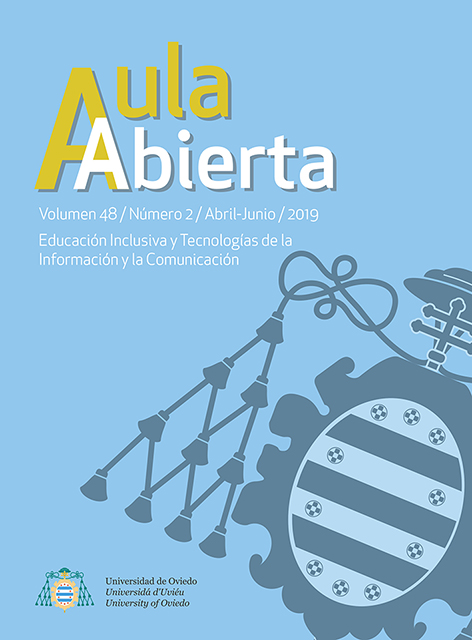Resumen
An inclusive teacher is one who considers diversity as a positive feature that enriches education and who, therefore, adapts the teaching methodologies to the learning characteristics of each one of the students and provides support to all their needs. Many research projects emphasize the idea of how students´ success depends largely on the teachers' preparation and their competencies and attitudes. The goal of this work is to present the review and resulting modification of an instrument to assess teacher training needs for inclusion (CEFI-R). For this purpose, we used a sample of 202 Spanish teachers with experience in all educational stages (preschool, primary and secondary education). The validation process is described (the process of item inclusion and exclusion, the factorial analysis in order to analyze the structure of the questionnaire and the internal consistency of the scale) which resulted in the development of a 19-item questionnaire grouped into 4 inclusion indicators: conception of diversity, methodology, supports and community participation. We can come to the conclusion that the CEFI-R is a multidimensional tool that allow us to analyze the main aspects in which teachers are less prepared to meet the diverse needs and characteristics of their students.
Citas
Ahmmed, M., Sharma, U., & Deppeler, J. (2014). Variables affecting teachers’ intentions to include students with disabilities in regular primary schools in Bangladesh. Disability and Society, 29(2), 317-331. doi: https://doi.org/10.1080/09687599.2013.796878
Author 2013 [details removed for peer review]
Author 2014 [details removed for peer review]
Avramidis, E., & Kalyra, E. (2007). The influence of teaching experience and professional development on Greek teachers ‘attitudes towards inclusion. European Journal of Special Needs Education, 22(4), 367-389. doi: https://doi.org/10.1080/08856250701649989
Bandalos, D. L., & Finney, S. J. (2010). Factor analysis: exploratory and confirmatory. In G. R. Hancock & R. O. Mueller (Eds.), The reviewer’s guide to quantitative methods in the social sciences (pp. 93–114). New York, NY: Routledge.
Barber, M., & Mourshed, M. (2007). How the world’s best performing school systems come out on top. Retrieved from http://mckinseyonsociety.com/how-the-worlds-best-performing-schools-come-out-on-top/
Booth, T., & Ainscow. M. (2002). Index for Inclusion. Developing leaning and participation in schools (2nd ed.). Manchester, UK: CSIE.
Booth, T., & Ainscow, M. (2011). Index for inclusion. Developing learning and participation in schools (3rd ed.). Manchester, UK: CSIE.
Booth, T., Ainscow, M., & Kingston, D. (2006). Index for inclusion: Developing play, learning and participation in early years and childcare. Bristol, UK: CSIE.
Colmenero, M. J., Pantoja, A., & Pegajalar, M. C. (2015). Percepciones sobre atención a la diversidad en la formación inicial del profesorado en educación secundaria. Revista Complutense de Educación, 26(1), 101-120. doi: http://dx.doi.org/10.5209/rev_RCED.2015.v26.n1.42616
Council of the European Union (2010). Council conclusions on the social dimension of education and training, 3013 Meeting of the Education, Youth and Culture Council. Brussels: Council of the EU. Retrieved from http://www.european-agency.org/news/news-files/Council-Conclusions-May-2010-social-Dimension.PDF/view
Dias, P.C., & Cadime, I. (2016). Effects of personal and professional factors on teachers’ attitudes towards inclusion in preschool. European Journal of Special Needs Education, 31(1), 111-123. doi: https://doi.org/10.1080/08856257.2015.1108040
Donnelly, V., & Watkins, A. (2011). Teacher education for inclusion in Europe. Prospects, 41, 341–353.
European Agency for Development in Special Needs Education (2011). Teacher education for inclusion across Europe. Challenges and opportunities. Odense, Denmark: Author.
European Agency for Development in Special Needs Education (2012). Teacher education for inclusion. Profile of inclusive teachers. Odense, Denmark: Author.
Florian, L. (2012). Preparing teachers to work in inclusive classrooms: Key lessons for the professional development of teacher educator from Scotland’s Inclusive Practice Project. Journal of Teacher Education, 63(4), 275-285. doi: 10.1177/0022487112447112
Forlin, C., Earle, C., Loreman, T., & Sharma, U. (2011). The sentiments, attitudes, and concerns about inclusive education revised (SACIE-R). Scale for measuring pre-service teachers’ perceptions about inclusion. Exceptionality Education International, 21(3), 50-65.
Grieve, A. M. (2009). Teachers´ beliefs about inappropriate behavior: Challenging attitudes? Journal of Research in Special Educational Needs, 9, 173-179. doi: 10.1111/j.1471-3802.2009.01130.x
Hattie, J. (2005). What is the nature of evidence that makes a difference to learning? Paper presented at the ACER Conference, Melbourne. Retrieved from http://www.acer.edu.au/workshops/documents/HattieSlides.pdf
Hoyle, R. H., & Duvall, J. L. (2004). Determining the number of factors in exploratory and confirmatory factor analysis. En D. Kaplan (Ed.), The SAGE handbook of quantitative methodology for social sciences (pp. 301–315). Thousand Oaks, CA: Sage.
Kraska, J., & Boyle, C. (2014). Attitudes of preschool and primary school pre-service teachers towards inclusive education. Asia-Pacific Journal of Teacher Education 42(3), 228–246. doi: https://doi.org/10.1080/1359866X.2014.926307
Lerman, Z.M. (2017). Making Science Education Accessible to All. Aula Abierta, 46, 13-16.
Mahat, M. (2008). The development of a psychometrically sound instrument to measure teachers’ multidimensional attitudes toward inclusive education. International Journal of Special Education, 23(1), 82-92.
Molina, S., & Holland, CH. (2010). Educación especial e inclusión: aportaciones desde la investigación. Revista Educación y Pedagogía, 22(56), 31-43.
Rodríguez, A., & Álvarez, E. (2013). Development and validation of a scale to identify attitudes towards disability in higher education. Psicothema, 25(3), 370-376. doi: 10.7334/psicothema2013.41
Sharma, U., Loreman, T., & Forlin, C. (2012). Measuring teaching efficacy to implement inclusive practices. Journal of Research in Special Education Needs, 12, 12-21. doi: 10.1111/j.1471-3802.2011.01200.x
Sharma, U., & Jacobs, DT. K. (2016). Predicting in-service educators’ intentions to teach in inclusive classrooms in India and Australia. Teaching and Teacher Education, 55, 13-23. doi: https://doi.org/10.1016/j.tate.2015.12.004
Soldevilla, J., Naranjo, M. & Muntaner, J.J. (2017). Inclusive practices: the role of the support teacher. Aula Abierta, 46, 49-56.
Weiß, S., Kollmannsberger, M., Lerche, T., Oubaid, V., & Kiel, E. (2014). The pedagogic signature of special needs education. European Journal of Special Needs Education, 29 (2), 200-219. doi: https://doi.org/10.1080/08856257.2014.895554





